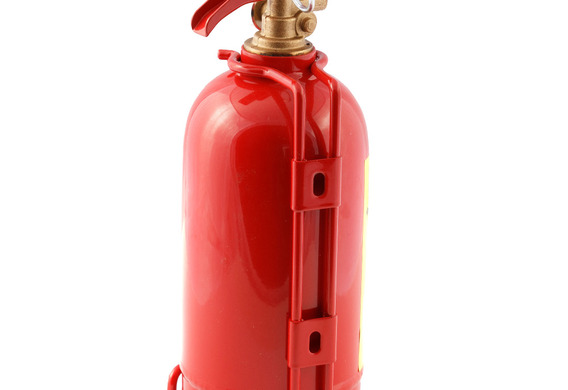
A fire extinguisher is required in a vehicle not only for inspection. There are situations in which a fire extinguisher can save a car, as well as the health and life of the driver and passengers. That is why the fire extinguisher needs to be carefully selected. So, what fire extinguisher to choose not to worry about the safety of the car and your life? Types of fire extinguishers
Types of fire extinguishers
There are three basic types of fire extinguishers:
- Aerosol fire extinguishers;
- Carbon acid fire extinguishers;
- Powder powder.
There are also fire extinguishers and even fire extinguishers filled with water. However, they are completely unsuitable for the car because, first, it is guaranteed to have a short circuit when extinguishing, and, secondly, it is not able to extinguate the burning wiring and fuel and lubricants.
Aerosol, foam and water extinguishers not suitable for car
Aerosol fire extinguishers are usually a regular container such as air freshness or hair spray. Such fire extinguishers are intended to extinguisher small fires and are not capable of extinguishing the wiring, oil and lubricants or plastic.
Only powder or carbon-acid fire extinguishers will be suitable for the vehicle. The fire extinguisher for the passenger car shall be not less than 2 litres, and for goods not less than 5 (Annex 4 of the Air Safety Manual).
powder extinguisher
The powder extinguisher is most often used in motor vehicles. Inside the container, there is a pressurized powder, which is thrown through a special valve outside. The advantage of powdery is that it covers the place of ignition and does not evaporates, cutting off the access of oxygen. This is especially important when driving a burning vehicle.

The powder extinguisher shall be marked with at least B. A good powder extinguisher shall be able to handle all types of ignition (A, B, C, D, E). It is also important that the extinguisher can operate in a wide range of temperatures (ideally from -50 to +50 degrees Celsius). Main types of ignition with which the extinguisher should be able to fight: A-solid flammable substances, B-liquid combustible substances, E-electrical equipment under voltage.
There are two types of powder extinguishers:
- the temperate (already filled with gas that will push the powder),
- with a gas-generating cartridge or a high pressure cylinder (gas produced by chemical reactions)
It is better to choose a hardened fire extinguisher, because it works faster (do not have to wait for a chemical reaction). It may be obtained by means of a pressure gauge indicating the pressure inside the container.
A good automotive fire extinguisher shall be able to cope with solid combustible materials, combustible fluids and live voltage. The letters A, B and E must be found on the label.
The powder extinguisher has a drawback: it will not be easy to remove the powder from the place of the extinguisher. But this is the minimum wage for high efficiency.
CO2-type device
The principle of carbon dioxide fire extinguishers is that they replace oxygen with carbon dioxide, which does not support combustion. The temperature of the fire extinguisher is between -70 and -90. We need to keep the gas out of the open areas, because it can cause frostbite. It is also harmful to breathe carbon dioxide, so such fire extinguishers are intended to be used in the open. The advantage is often greater efficiency than powder extinguishers.
What to pay attention to when choosing
The extinguisher's term of service is typically 10 years, so it is necessary to find the date of manufacture on the container before purchase.
The automatic fire extinguishers, like any other, need to be checked on a regular basis:
- control of the state of the fire-extinguishing powder, at least once every five years,
- Inspection of the fire extinguisher, at least once every 5 years,
- Checking of the working gas pressure in the fire extinguisher-at least once every quarter.
The fire extinguisher shall be metal. If the extinguisher is equipped with a pressure gauge, the pressure switch shall be in the green area. The check of the extinguisher shall be sealed and the kit must contain the rastre. It will also be necessary to ask the seller for a certificate for a fire extinguisher.
Bought and forgot?
It's not enough to buy a fire extinguisher and put it in the boot. It is necessary to examine the method of activation of the fire extinguisher in order not to lose precious seconds in an emergency situation and also to regularly check the pressure. About once a year and a half the fire extinguisher has to be changed.
It is important that the fire extinguisher is always at hand, so the trunk is not the best place for it. The extinguisher can be secured by or under the driver's seat or side, if possible. The extinguisher shall be secure but easy to release in an emergency.
Ideally, there is one fire extinguisher in the car 2-one powder and one carbon dioxide. The powder will be better able to deal with the transaction's extinguishings, and the carbonic acid will quickly put out the plastic.
Where do you put the old one?
The old extinguisher can't just be thrown away. The extinguisher must be discharged. The instruction shall be on the container. Then remove the top part. If the extinguisher powder is powder, the powder must be cleaned. The cylinder itself shall be inoperable (for example, by cutting the threads at the top of the container or by drinting the hole in the shell). Metal parts can be thrown at scrap metal, other elements can be thrown away.
So the extinguisher must be in the car. When purchasing this required item, you must first pay attention to the type of fire extinguisher, body material, date of manufacture, cylinder capacity, and types of fires that a particular instance can handle.









